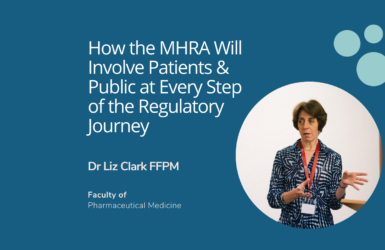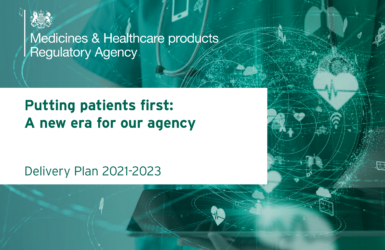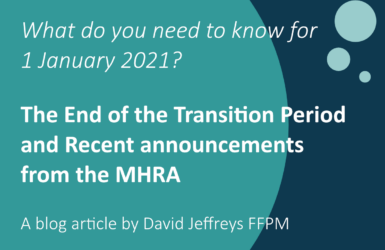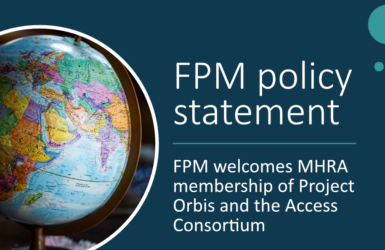How the MHRA Will Involve Patients & Public at Every Step of the Regulatory Journey
Posted on: Monday 11 October 2021
Author: Dr Liz Clark FFPM
This article has been prepared by Dr Liz Clark FFPM.
It is provided for information and does not constitute advice or represent official FPM views or policy.
How to cite:
Clark, L. (2021), ‘How the MHRA Will Involve Patients & Public at Every Step of the Regulatory Journey’, Faculty of Pharmaceutical Medicine blog, 08 October 2021. Available at: https://www.fpm.org.uk/blog/how-the-mhra-will-involve-patients-and-public-at-every-step-of-the-regulatory-journey/ (Accessed: <date>).
Written under the shadow of Covid, the MHRA published its Patient Involvement Strategy 2021-25 last week.
Not surprisingly, many of FPM’s own current and planned activities share themes in common with the MHRA’s strategy: Inclusion throughout the pharmaceutical medicine specialist training syllabus; active membership of the Inequalities in Health Alliance, championing under-served communities, and highlighting the role that diversity and inclusion play in clinical trials; exploring the nuances of patient engagement in rare diseases, especially children; and post-COVID-19 public understanding of risk of medicines, devices and vaccines, and how this is best communicated. In the interests of collaboration and sharing experience, the MHRA strategy therefore informs experience and action both at group and individual level.
The MHRA is to be congratulated on this document. True to “Nothing about us without us”, patients and members of the public have evidently been involved in its creation, and this resonates throughout the document. Written in plain English the strategy to achieve the MHRA’s vision of ‘being a patient focused regulator’ is organised under five interrelated objectives with specific timings for delivery, the foundational work for the most part within the next 14 months.
- Patient and Public Involvement
- Responsiveness
- Internal Culture
- Measuring Outcomes
- Partnerships
"Our core focus will be on patients and the public, placing them at the heart of our thinking."
MHRA Patient Involvement Strategy 2021-25
The first objective, “Patient & Public Involvement’, not surprisingly, has a major focus on process development to underpin a systematic approach. Willingness to go beyond what is certain and controllable is always a challenge when developing strategy, but the MHRA has tackled this with statements of intent, backed up by examples of how they might achieve this. Inclusion of poorly represented groups, children and young people; learning from and collaborating with other regulators and stakeholders all feature, underpinned by examples of how these intentions might be achieved. Some, such as ‘Commissioning research on post COVID-19 public understanding of risk’ are very specific; others, such as ‘Increasing involvement of patients and the public in drafting public-facing information material’ quite appropriately allow room for iterative development, running in parallel with more concrete plans for patient and public consultation.
Patient and public engagement is no different to any other relationship in that both parties need to deliver on their promises, and the second objective, ‘Responsiveness’ recognises the need for this in order to build confidence and trust to sustain and grow the relationship. Not surprisingly, refining systems and standards of service delivery and continued development of the Customer Service Centre, together with optimising online channels form the backbone of this objective. However, there is clear recognition of the need to hold the patient in mind, which flows nicely into objective three, ‘Internal Culture’.
"We focus outwards on patients and the public."
MHRA Patient Involvement Strategy 2021-25
Cultural change can be a slippery challenge – relatively easy to define, but infinitely harder to embed. This section contains a number of relatively simple actions, many similar in nature to what we have seen in pharma, such as inclusion of patient focus into staff induction; specific training on engaging with patients and the public; share examples of good practice; and most importantly a regular patient speaker programme. In my experience nothing is quite as powerful as meeting ‘patients as people’ – inspiring and insightful. My own piece of advice here is to make sure that engagement is two way – in my experience patients wanted to know as much about us as we did about them.
However easy it can be to get carried away in cultural aspiration, the authors clearly recognise that what gets planned and measured gets done, and there is a commitment to reflect patient focus in goal plans for staff and find ways to measure progress. This is the focus of the fourth objective, which considers engagement outcomes.
The experience of the pandemic surely informs the reflection that, ‘Our engagement outcomes are an important driver of our overall reputational measure of trust in the MHRA and in public confidence in medicines and medical devices.’ Potential areas for monitoring range from speed of patient involvement in signal management, the proportion of protocols featuring patient reported outcomes, the creation of a patient engagement index and a variety of channels and modalities for feedback, together with benchmarking across geographies and sectors.
"Introduce new ways of working…..with patients and the public central in how we develop our new operating model for the agency."
MHRA Patient Involvement Strategy 2021-25
Various measures to assess the all-important internal culture are also included, utilising existing surveys and introducing new metrics to demonstrate engagement with the speaker presentations, training etc. Whilst making great proof points and supporting progress when the inputs are demanding and outputs slow to appear, from experience I would suggest that these will be more likely to confirm what becomes evident as habits change. This was illustrated by a colleague of mine pointing out that a proposed ‘Signal to Pack’ project should rightfully be named ‘Signal to Patient’.
Collaboration and partnership run through patient involvement like letters in a stick of rock, and the strategy identifies three core areas of focus: insight exchange, patient engagement mechanisms and cross partnership working. This area of the strategy is less specifically defined than the others, but the heart of the thinking revolves around sharing and consolidation of data in coordination with health partners; overhauling the MHRA’s Patient Group Consultative Forum to improve its representativeness and diversity, all the while recognising that time it takes patients to contribute and working through existing groups where they meet needs. As the authors say, ‘It makes no sense for us to duplicate an already effective approach’.
So, having reached the end of the document, what does this mean for patients, public and pharma?
For the public and patients, the MHRA wants to involve you. Like all of us, they are bound to learn along the way, so please recognise that they are also on a journey with occasional mistakes. I took the opportunity to seek the opinions of two experienced patient advocates, Trishna Bharadia and Jane Leahy, whose comments can be seen to be reflective of the reaction in the experienced patient advocate community.
For pharma, the MHRA is sending out some clear messages in this document about the focus on the patient and public as the customer. Assessors will be looking for evidence of patient reported outcomes specifically and patient and public involvement generally.
And my thoughts?
Firstly, I applaud the approach, and willingness to lay out the intent where the path may not yet be clear. There is very little which seems to be missing – perhaps adding in the importance of external advocacy in the many patient engagement groups, conferences and fora – something the FDA have done particularly well. The strategy document acknowledges that investment will be required to deliver, and in the current climate, this may well be a constraint. However, much of the work on culture and mindset and to some extent monitoring can be achieved without extensive resources, and I believe that this mindset is key to ensuring that patient and public information remains a priority even under the sorts of pressures we have seen over the last 18 months. I therefore remain optimistic. My final thought is to wish the MHRA well, knowing that the hard work which walking the talk will inevitably involve will make a difference.
My thanks to Trishna and Jane for their speedy contributions to this perspective – ‘Nothing about us without us’, to Sheuli Porkess for her equally rapid review and insightful comment & the team at the Faculty of Pharmaceutical Medicine for their positive response and prompt publication.
Trishna Bharadia MFPM (HON), Award Winning Patient Advocate
“I clearly remember having a conversation with somebody from the MHRA a few years ago about whether the organisation was doing enough to engage with patients and the public. My answer then was clear. “No,” I said. “The very fact that most people or patients probably don’t even know who you are, what you do or that you even exist demonstrates that there is much work to be done.”
Fast forward to 2021 and it’s a great pleasure to see the MHRA develop such a comprehensive patient and public involvement strategy. Patient involvement in the medicines development lifecycle must be realistic, it must be intentional and it must be ambitious. This strategy is all three. What I like most is how it not only looks at how to engage with patients and the public but goes deeper, to address internal culture and, importantly, how to measure the outcomes.
It doesn’t just speak to theory, but includes supporting examples, to show how the MHRA intends to achieve what it’s setting out to do. I am optimistic that this will be a further step towards a more patient-focused future for medicines development and look forward to seeing what will be achieved.”
Jane Leahy, Bloodwise Patient Ambassador
“It’s very encouraging to see the MHRA publishing this first Patient Involvement Strategy document. They are making great strides to improve their culture, embedding patients at the heart of everything they do. It’s clear to see that patient organisations and the public have helped inform the publication of the strategy document.
I applaud the intentions of the MHRA and hope that they will be born out. The MHRA do point to this in the document and indicate that they will take an agile approach to it’s implementation, with patient and public input of course, reviewing and cementing what works and revising and improving what doesn’t. I wish them every success.”
About the Author:
Dr Liz Clark FFPM
Dr Clark is an independent pharmaceutical physician, with a dual focus on patient engagement together with education, coaching and mentoring. She delivers a mix of pro-bono and paid consultancy, training and facilitation work in the interests of furthering the cause of patient involvement in medicines development and healthcare
Linkedin: www.linkedin.com/in/drlizclark
Conflicts of Interest: none

More about the MHRA

A Mad Hatter’s Tea Party? (with apologies to Lewis Carroll)
The weird and wonderful changing world of the regulation of devices and diagnostics.

How the MHRA Will Involve Patients & Public at Every Step of the Regulatory Journey
Dr Liz Clark takes a look at the MHRA’s new Patient Involvement Strategy





